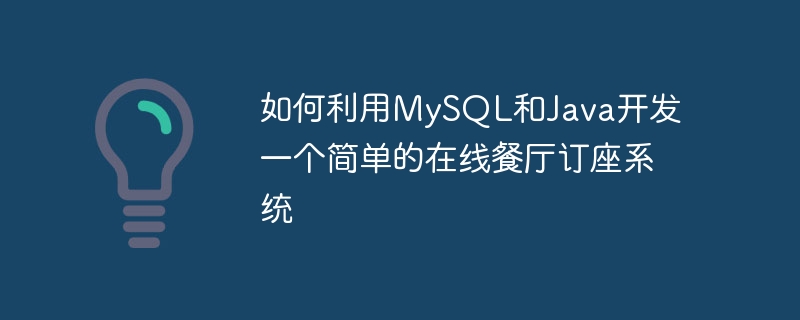

How to use MySQL and Java to develop a simple online restaurant reservation system
In today's society, with the continuous development of technology, more and more Business began to migrate online. Among them, the catering industry has also actively followed the trend and begun to launch online ordering and table reservation systems to facilitate customers to make reservations for meals. In this article, we will introduce how to use MySQL and Java to develop a simple online restaurant reservation system.
First of all, we need to design a suitable database to store restaurant, table and customer information. The following is a simple database design example:
Restaurant table: restaurant
Table table: table
Customer table: customer
Reservation table: reservation
Create the above in MySQL table and establish corresponding foreign key relationships.
Next, we use Java to develop the back-end system for processing business logic and interacting with the database. We can use the Spring Boot framework, which can quickly build a simple web application.
First, we need to create a Restaurant class to represent the restaurant. The specific code example is as follows:
@Entity @Table(name = "restaurant") public class Restaurant { @Id @GeneratedValue(strategy = GenerationType.IDENTITY) private Long id; private String name; private String address; // getters and setters }
Then, we create a Table class to represent the table. The code example is as follows:
@Entity @Table(name = "table") public class Table { @Id @GeneratedValue(strategy = GenerationType.IDENTITY) private Long id; @ManyToOne @JoinColumn(name = "restaurant_id") private Restaurant restaurant; private String number; private int capacity; // getters and setters }
Next, we create a Customer class to represent the customer, the code example is as follows:
@Entity @Table(name = "customer") public class Customer { @Id @GeneratedValue(strategy = GenerationType.IDENTITY) private Long id; private String name; private String phone; // getters and setters }
Finally, we create a Reservation class to represent the reservation information, the code example is as follows:
@Entity @Table(name = "reservation") public class Reservation { @Id @GeneratedValue(strategy = GenerationType.IDENTITY) private Long id; @ManyToOne @JoinColumn(name = "table_id") private Table table; @ManyToOne @JoinColumn(name = "customer_id") private Customer customer; private Date reservationTime; // getters and setters }
In Java, we need to use JPA to operate the database. In the Spring Boot project, we can use Spring Data JPA to easily implement database addition, deletion, modification and query operations.
In order to enable users to easily use the online reservation system, we need to create a simple front-end interface. Here we can use HTML and CSS to build the user interface and JavaScript for interaction.
First, we create an index.html file, the code is as follows:
Then, we can use JavaScript to handle the form submission event and send the data to the backend through Ajax, the code is as follows :
document.querySelector('form').addEventListener('submit', function(e) { e.preventDefault(); var tableId = document.getElementById('tableId').value; var name = document.getElementById('name').value; var phone = document.getElementById('phone').value; var data = { tableId: tableId, name: name, phone: phone }; // 发送Ajax请求 var xhr = new XMLHttpRequest(); xhr.open('POST', '/reservation', true); xhr.setRequestHeader('Content-Type', 'application/json'); xhr.send(JSON.stringify(data)); xhr.onreadystatechange = function() { if (xhr.readyState === XMLHttpRequest.DONE && xhr.status === 200) { // 处理响应数据 } }; });
The above code demonstrates how to process the form data submitted by the user and send it to the backend's/reservationinterface through Ajax.
After we have completed the database design, Java back-end development and front-end development, we can deploy and test our online restaurant reservation system .
First, we need to deploy the Java backend to the server and start the server. Then, place the front-end code in the server's static files directory. Finally, we can access the online restaurant reservation system by accessing the server's IP address or domain name.
When testing the system, you can simulate user behavior, such as selecting a restaurant, table, filling in personal information, and submitting a reservation request. The system will then process this data and return relevant information to the user.
Summary:
Through the above steps, we successfully developed a simple online restaurant reservation system. Through the combination of MySQL and Java, we can easily manage restaurant, table and customer information, and provide convenient online reservation services. This system can be used as an auxiliary tool for restaurant business, providing better user experience and service quality. Of course, this is just a simple example, you can further improve the function and optimize the code according to actual needs.
The above is the detailed content of How to develop a simple online restaurant reservation system using MySQL and Java. For more information, please follow other related articles on the PHP Chinese website!
